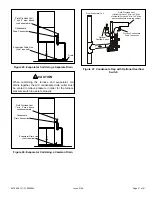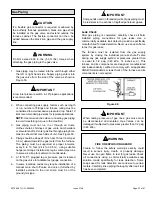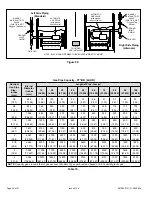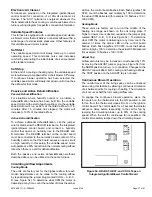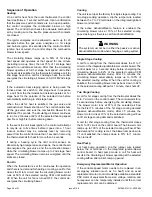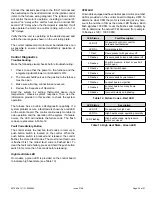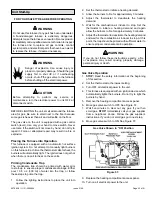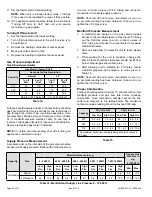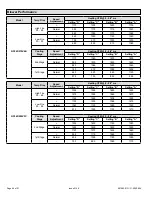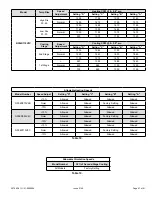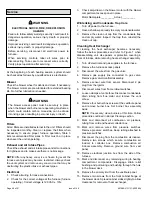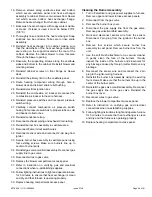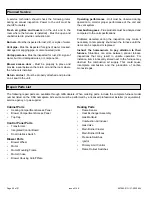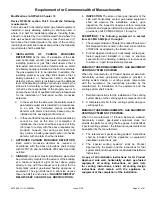
507962-01G / 31-5000654
Page 44 of 51
Issue 2149
Capacity
Gas
Manifold Pressure in w.g.
Supply Line
Pressure in
w.g.
0 - 10000 ft.
0 - 4500 ft.
4501 - 5500 ft.
5501 - 6500ft.
6501 - 7500ft.
7501-10000ft.
Low
Fire
High
Fire
Low
Fire
High
Fire
Low
Fire
High
Fire
Low
Fire
High
Fire
Low
Fire
High
Fire
Min. Max.
All Models
Natural
1.7
3.5
1.6
3.3
1.5
3.2
1.5
3.1
1.7
3.5
4.5
13.0
LP/Propane
4.5
10.0
4.2
9.4
4.0
9.1
3.9
8.9
4.5
10.0
11.0
13.0
Table 16.
Manifold and Supply Line Pressure 0 - 10,000 ft.
11. Set the thermostat to desired setting.
NOTE:
When unit is initially started, steps 1 through
11 may need to be repeated to purge air from gas line.
12. If the appliance will not operate, follow the instructions
“Turning Off Gas to Unit” and call your service
technician or gas supplier.
Turning Off Gas to Unit
1. Set the thermostat to the lowest setting.
2.
Turn off all electrical power to the unit if service is to
be performed.
3. Remove the heating compartment access panel.
4. Move gas valve switch to OFF.
5. Replace the heating compartment access panel.
Gas Pressure Adjustment
Gas Flow (Approximate)
Table 14.
Gas Meter Clocking Chart
Capacity
Seconds for One Revolution
Natural
LP
1 cu ft
Dial
2 cu ft
Dial
1 cu ft
Dial
2 cu ft
Dial
070
55
110
136
272
090
41
82
102
204
110
33
66
82
164
Natural - 1000 btu/cu ft
LP - 2500 btu/cu ft
Furnace should operate at least 5 minutes before checking
gas flow. Determine time in seconds for two revolutions of
gas through the meter. (Two revolutions assures a more
accurate time.) Divide by two and compare to time in Table
14. If manifold pressure matches Table 16 and rate is
incorrect, check gas orifices for proper size and restriction.
Remove temporary gas meter if installed.
NOTE:
To obtain accurate reading, shut off all other gas
appliances connected to meter.
Supply Pressure Measurement
A pressure post on the inlet side of the gas valve provides
access to the supply pressure. Back out the 3/32 Hex screw
one turn, connect a piece of 5/16” tubing and connect a
manometer to measure supply pressure.
NOTE:
Shut unit off and remove manometer as soon as
an accurate reading has been obtained. Take care to re-
tighten the 3/32 Hex screw.
Manifold Pressure Measurement
1. A manifold post located on the gas valve provides
access to the manifold pressure. See Figure 57. Back
out the 3/32 Hex screw one turn, connect a piece of
5/16” tubing and connect to a manometer to measure
manifold pressure.
2. Start unit and allow 5 minutes for unit to reach steady
state.
3. While waiting for the unit to stabilize, observe the
flame. Flame should be stable and should not lift from
burner. Natural gas should burn blue.
4. After allowing unit to stabilize for 5 minutes, record
manifold pressure and compare to value given in
NOTE:
Shut unit off and remove manometer as soon as
an accurate reading has been obtained. Take care to re-
tighten the 3/32 Hex screw.
Proper Combustion
Furnace should operate minimum 15 minutes with correct
manifold pressure and gas flow rate before checking
combustion. Take combustion sample beyond the flue
outlet and compare to the tables below. The maximum
carbon monoxide reading should not exceed 100 ppm.
Table 15.
Capacity
CO
2
% for Nat
CO
2
% for L.P.
Low Fire
High Fire
Low Fire
High Fire
070
5.5 - 6.5
7.3 - 8.3
6.5 - 7.5
8.6 - 9.6
090
5.9 - 6.9
7.8 - 8.8
6.9 - 7.9
9.1 - 10.1
110
6.3 - 7.3
8.2 - 9.2
7.3 - 8.3
9.5 - 10.5
The maximum carbon monoxide reading should not exceed
100 ppm.


